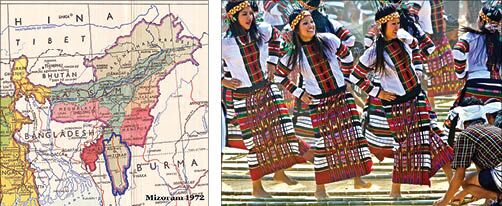Insurgency to integration
While the Mizo Union wanted a separate state from Assam within India and the MNF took to violent means for a sovereign state, the eventual outcome was formation of a Union Territory under NER Act, 1971

A step motherly treatment meted out to the Mizo Hills (by Assam government) is responsible for the unfortunate feeling of discontent that we are being treated as second rate citizens ...unless the political aspirations of Mizos are fulfilled through the creation of Mizoram, as there is no desire to remain part of Assam, there is still that sincere desire in the hearts of majority of Mizos to feel themselves as Indians."
This was the memorandum submitted by both the Mizo Union and the MNF to Prime Minister Lal Bahadur Shastri after the appointment of the Pataskar Commission. As argued in the previous column, the main angst was not against the Government of India, but against the provincial government of Assam which, in turn, was hell bent on scuttling the autonomy of the autonomous district councils envisaged under the Sixth schedule. In fact, it can well be argued that had an honest attempt been made to implement the 'letter and spirt' of the Sixth schedule, Assam may have retained its geographical boundaries because before the establishment of Nagaland the general feeling in the political community was that larger states would be better equipped to face the challenges of economic growth and border protection.
Having said this, it must be pointed out that while there was absolute unanimity about wanting to get out of Assam, the Mizo Union wanted a state within India, but the MNF which had its origins in the Mizo National Famine Front established in 1960 wanted a sovereign Mizo state. From 1959, the entire region had been ravaged by a debilitating famine, the attitude and response of the Assam government was callous and indifferent. This alienated all sections of the Mizo society, and the attempt to impose Assamese as the administrative language for the entire state aggravated this feeling of discontent and frustration.
In fact, right from 1952, when the District Council in the Lushai Hills was established under the Sixth Schedule, there was a clear feeling that the government of Assam was hell bent on making it a moribund entity. While the old chieftain system had collapsed, the new Council was quite weak to step into its shoes. Even though the Mizo Union had won the elections — both to the Advisory Council in 1948 and the territorial in 1952 — the traditional chiefs, who held hereditary power under the old dispensation, were clearly opposed to them.
In their memorandum submitted to the SRC, the Mizo Union which was dominating the District Council sought the inclusion of Mizo-dominated areas of Manipur and Tripura in the Lushai Hills. This reconstituted district was to be a part of the Eastern Hills State comprising Manipur and Tripura along with the autonomous districts of Assam and NEFA. However, given the linguistic and ethnic diversity in the proposed Hill state, the Mizos reneged from their position, and pressed for a separate Mizoram state within the Indian Union.
After 1961, there was a clear split between the Mizo Union and the MNF — which declared its aim for a sovereign Mizoram. By 1963, MNF gained currency, especially among the youth, but though it captured 145 village councils, the Mizo Union was still the dominant political force – it had 220 village councils with it. But the Laldenga-led MNF, egged on by its supporters in East Pakistan, launched Operation Jericho — an armed struggle for a sovereign Mizoram by launching simultaneous attacks on the Assam Rifles (AR) garrisons at Aizawl, Lunglei and Champhai; BSF outposts and the Aizawl Treasury on March 1,1966. Even the Deputy Commissioner of Aizawl, TS Gill, had to take shelter in the Assam Rifles (AR) camp. But the AR garrison held on, and the proposed victory parade scheduled for March 2 could not be held, for the insurgents had underestimated the strength of the Indian army and overestimated the support of ISI and East Pakistan. Even though the insurgents could not hoist the flag, they released the prisoners from the Aizawl jail and looted the shops of the non-Mizos (Vais).
On March 2, 1966, AFSPA was invoked, curfew was imposed in Aizawl and reinforcements were sent for Assam Rifles by helicopters. After the attack on the chopper of Eastern Army commander Lt Gen Sam Manekshaw, IAF jets strafed the MNF insurgent posts using machine guns on March 4 / 5 — the one and only instance of combat action by IAF within the country.
Among all this, the Mizo Union was steadfast in its support for India. Their biggest grouse was that the CM of Assam, BP Chaliha, was supporting MNF — a secessionist organisation — because for him, "the disintegration of the state of Assam is more serious than the amputation of Mizo Hills from India." It may not be true, but this was certainly the popular perception. Meanwhile, in October 1966, the Governor of Assam Vishnu Sahay suggested that "Mizo hills should be plucked from Assam and formed into a Union territory". The GoI was also cognisant of the fact that the Autonomous Councils under the Sixth Schedule had failed to meet the political aspirations. The Mizo Union presented a memorandum to Prime Minister Indira Gandhi in December 1970 for a full-fledged state, but a compromise was struck with the enactment of North-Eastern (Areas) Reorganisation Act, 1971, under which Mizoram was formed into a UT with 33 legislators and one seat each in the Lok Sabha and the Rajya Sabha.
Views expressed are personal



